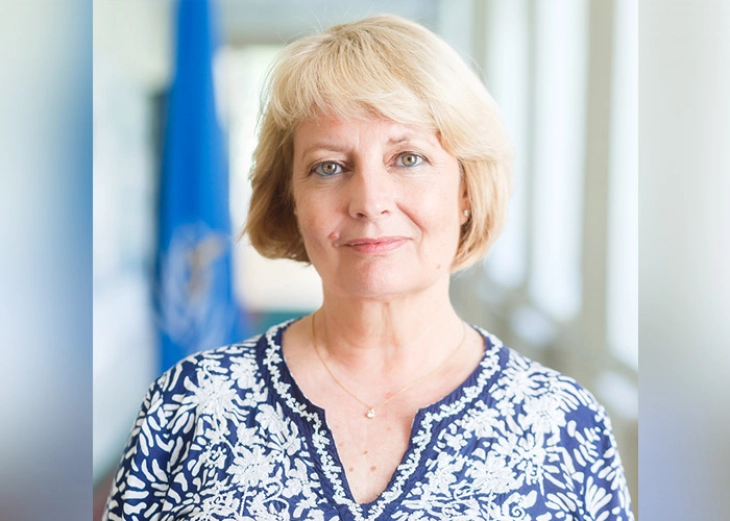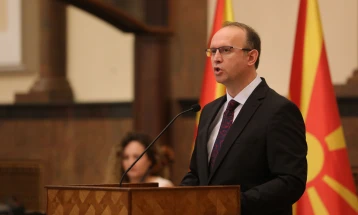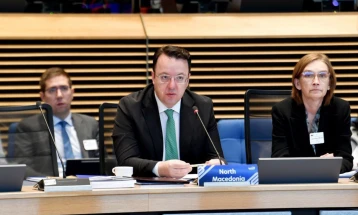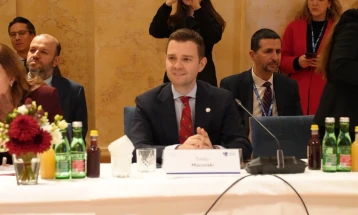Johansen: Monkeypox spreads through close contact, detection and isolation key for dealing with the disease

Skopje, 11 August 2022 (MIA) – Unlike Covid-19, usually monkeypox does not easily spread between humans, for that to happen close contact which would allow the virus to enter the body through a skin cut (even when not visible), the respiratory tract or the mucous membranes (eyes, nose or mouth) is necessary, as well as bodily fluids or prolonged contact with objects contaminated by them (clothes, bedding, towels etc.) the World Health Organization (WHO) Regional Director's Special Representative for North Macedonia, Dr. Anne Johansen tells MIA.
Symptoms are usually mild and in the form of lesions which can be very itchy or painful. A rash with blisters appears on the face, hands, feet, eyes, mouth and/or the genitals (during the current outbreak, most reported cases have genital or perianal rashes), fever, swollen lymph nodes, headaches, muscle aches and low energy levels. However, Johansen says, monkeypox can be a serious illness, especially when it comes to children, pregnant women and immunocompromised individuals.
The American Center for Disease Control and Prevention (CDC) states that monkeypox can spread to anyone through close skin-to-skin contact with an infected person, intimate physical contact – oral, anal or vaginal sex or touching the genitals of a person with monkeypox. Additionally, it can be transmitted through hugging, massage and kissing, touching objects such as clothes, towels, bedding used by a person with monkeypox which have not been disinfected. Pregnant women can spread the virus to their fetus through the placenta. A person with monkeypox can spread it to others from the time symptoms start until the rash has fully healed. Scientists are still researching if the virus can spread when someone has no symptoms, as well as how often monkeypox spreads through respiratory secretions.
In North Macedonia, on Wednesday a sample from a suspected case was delivered at the Institute of Public Health for testing. The suspected case was a man from Kichevo who reported having a rash, which is one of the symptoms of monkeypox.
The Infectious Diseases Commission recommends that suspected cases should isolate at home or at a hospital until they get tested, the isolation of confirmed cases lasts until the end of the disease or until the scabs heal. The Commission also recommends daily epidemiological tracing of the contacts of confirmed cases during the 21-day incubation period.
Timely detection and isolation key for dealing with the disease
The WHO Representative in the country says that the important measures for controlling the monkeypox epidemic are early detection, contact tracing and their isolation. According to Johansen, raising risk awareness and community engagement are of essential importance as well. Countries should cooperate with each other and with the WHO, securing the necessary aid through bilateral, regional and multilateral channels, and they should also follow the guidelines given by the WHO, says Johansen.
Johansen tells MIA that Covid-19 and monkeypox are two very different viruses and diseases. While the Covid-19 pandemic resulted in over two million deaths in Europe, the initial reported cases of monkeypox are mainly mild.
“Most of the cases currently examined in Europe are mild. We know that although monkeypox resolves on its own in most cases, it has the potential to cause severe complications. Around eight percent of the currently reported cases have ended up in a hospital in order to isolate or receive treatment,” says Johansen.
The most common reasons for hospitalization of the infected are pain treatment, secondary infections and in a small number of cases the reasons are certain life-threatening complications such as brain inflammation.
The Infectious Diseases Commission President, Aleksandar Petlichkovski does not expect this disease to become an issue like the coronavirus.
“Transmission is not as fast as we initially feared. It is transmitted in certain groups. In the whole world, vaccinations are recommended for at-risk groups, who have high-risk contacts. Mass immunization is not being planned anywhere at the moment,” says Petlichkovski.
Risk of rising monkeypox infections during the summer period According to the WHO assessment, monkeypox risk is considered to be moderate on a global level and in all six WHO regions, except for the European region, where it is considered to be high. “Around 55 percent of confirmed cases of monkeypox in the world in the past month have been reported in the European region, with four countries (Spain, the United Kingdom, Germany and France) reporting 76 percent of cases,” says Johansen. From mid-May to August 9, more than 17.800 confirmed or probable cases of monkeypox have been reported in 40 countries, two deaths have also been reported in Spain. With the continued transmission of monkeypox in Europe, according to Johansen, a greater number of severe and fatal cases is expected. “Our goal has to be to quickly stop the transmission of the disease in Europe and to reduce the number of cases with the help of a series of measures that are available to us,” she adds. The WHO Regional Director's Special Representative to North Macedonia says that the WHO recommends that skin-to-skin or face-to-face contact with those who have symptoms and contact with clothes or bedding used by an infected person, are avoided. Safe sex and regular handwashing are recommended, especially before and after contact with a person showing symptoms or objects used by them.
Vaccination for the prevention of monkeypox
The European Medicines Agency approved the monkeypox vaccine, and according to data from the WHO the traditional smallpox (variola vera) vaccine provides protection as well, but these vaccines are not widely available. “At the moment, the WHO does not recommend mass monkeypox vaccinations, keeping in mind the fact that in most cases monkeypox resolves on its own, i.e., symptoms disappear after around two to three weeks,” says Johansen. The WHO recommends targeted vaccination for people who may have been exposed to monkeypox or have a high risk of exposure, this includes health workers, certain laboratory workers and people with multiple sexual partners. “The decision whether someone will be vaccinated should be made jointly by the person who may be at risk and their doctor, on the basis of an assessment of the risks and benefits of receiving a vaccine which should be done individually for each specific case,” she adds. Health Minister Bekim Sali recently told the media that there is a sufficient number of tests in case of a potential appearance of monkeypox. “Regarding vaccines, I received confirmation from the national immunization coordinator that there are enough vaccines in case an infection is detected,” said Sali. The WHO points out that monkeypox vaccination does not provide immediate protection against infection and this might require multiple weeks. “This means that those who have been vaccinated should continue to follow the safety measures by avoiding close contacts, including sex, with other infected people or people at risk of monkeypox,” says Dr. Anne Johansen.
WHO recommendations for dealing with the monkeypox situation
“Even in countries which are yet to report monkeypox cases, it is important for the public health institutions to quickly and significantly reinforce the national capacities for monitoring, testing, diagnostics and contact tracing, in order to identify and trace each potential case,” said Anne Johansen and added that large numbers of cases likely remain undetected, further fueling the epidemic. Johansen urges any person who notices an unusual rash to contact their GP. When it comes to the doctors, she recommends that any patient with suspected monkeypox should be tested and isolated for the duration of the presumed infectious period of the disease (from the moment of the initial symptoms), that is, the known infectious period (the appearance of the rash). Hand hygiene and respiratory hygiene, along with personal protective equipment and appropriate isolation of suspected and confirmed cases, are also essential for the reduction of transmission within the healthcare facilities themselves. These are the same measures that were recommended and are being applied for Covid-19. “Faced with the uncertainty of what the future holds, countries must cooperate and exchange information, in order to make the most of every opportunity to predict, control and stop the transmission of this virus, which we still have much to learn about,” Dr. Anne Johansen tells MIA. Kristina Ivanovska Translated by Angel Dimoski
Risk of rising monkeypox infections during the summer period According to the WHO assessment, monkeypox risk is considered to be moderate on a global level and in all six WHO regions, except for the European region, where it is considered to be high. “Around 55 percent of confirmed cases of monkeypox in the world in the past month have been reported in the European region, with four countries (Spain, the United Kingdom, Germany and France) reporting 76 percent of cases,” says Johansen. From mid-May to August 9, more than 17.800 confirmed or probable cases of monkeypox have been reported in 40 countries, two deaths have also been reported in Spain. With the continued transmission of monkeypox in Europe, according to Johansen, a greater number of severe and fatal cases is expected. “Our goal has to be to quickly stop the transmission of the disease in Europe and to reduce the number of cases with the help of a series of measures that are available to us,” she adds. The WHO Regional Director's Special Representative to North Macedonia says that the WHO recommends that skin-to-skin or face-to-face contact with those who have symptoms and contact with clothes or bedding used by an infected person, are avoided. Safe sex and regular handwashing are recommended, especially before and after contact with a person showing symptoms or objects used by them.
Vaccination for the prevention of monkeypox
The European Medicines Agency approved the monkeypox vaccine, and according to data from the WHO the traditional smallpox (variola vera) vaccine provides protection as well, but these vaccines are not widely available. “At the moment, the WHO does not recommend mass monkeypox vaccinations, keeping in mind the fact that in most cases monkeypox resolves on its own, i.e., symptoms disappear after around two to three weeks,” says Johansen. The WHO recommends targeted vaccination for people who may have been exposed to monkeypox or have a high risk of exposure, this includes health workers, certain laboratory workers and people with multiple sexual partners. “The decision whether someone will be vaccinated should be made jointly by the person who may be at risk and their doctor, on the basis of an assessment of the risks and benefits of receiving a vaccine which should be done individually for each specific case,” she adds. Health Minister Bekim Sali recently told the media that there is a sufficient number of tests in case of a potential appearance of monkeypox. “Regarding vaccines, I received confirmation from the national immunization coordinator that there are enough vaccines in case an infection is detected,” said Sali. The WHO points out that monkeypox vaccination does not provide immediate protection against infection and this might require multiple weeks. “This means that those who have been vaccinated should continue to follow the safety measures by avoiding close contacts, including sex, with other infected people or people at risk of monkeypox,” says Dr. Anne Johansen.
WHO recommendations for dealing with the monkeypox situation
“Even in countries which are yet to report monkeypox cases, it is important for the public health institutions to quickly and significantly reinforce the national capacities for monitoring, testing, diagnostics and contact tracing, in order to identify and trace each potential case,” said Anne Johansen and added that large numbers of cases likely remain undetected, further fueling the epidemic. Johansen urges any person who notices an unusual rash to contact their GP. When it comes to the doctors, she recommends that any patient with suspected monkeypox should be tested and isolated for the duration of the presumed infectious period of the disease (from the moment of the initial symptoms), that is, the known infectious period (the appearance of the rash). Hand hygiene and respiratory hygiene, along with personal protective equipment and appropriate isolation of suspected and confirmed cases, are also essential for the reduction of transmission within the healthcare facilities themselves. These are the same measures that were recommended and are being applied for Covid-19. “Faced with the uncertainty of what the future holds, countries must cooperate and exchange information, in order to make the most of every opportunity to predict, control and stop the transmission of this virus, which we still have much to learn about,” Dr. Anne Johansen tells MIA. Kristina Ivanovska Translated by Angel Dimoski







